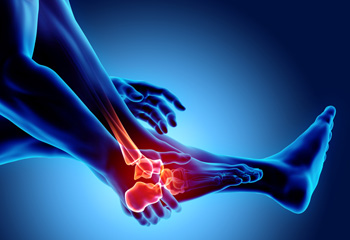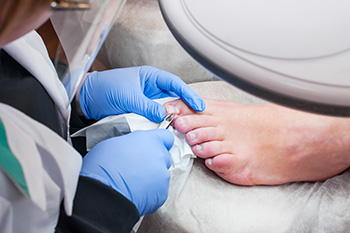Items filtered by date: October 2025
Preventing Foot and Ankle Injuries in Runners

Runners are prone to foot and ankle injuries due to repetitive impact, improper footwear, or overtraining. Common issues include sprains, tendonitis, and stress fractures that can disrupt training and daily activities. Preventing running injuries begins with wearing supportive shoes, gradually increasing mileage, and incorporating strengthening and stretching exercises. The calf stretch improves flexibility in the Achilles tendon, while the figure four stretch helps release tension in the feet and ankles. These exercises promote stability and reduce the risk of injury. If you have endured a foot or ankle injury while running, it is suggested that you consult a podiatrist who can assess your gait, recommend custom orthotics, and design a personalized recovery plan.
Exercising your feet regularly with the proper foot wear is a great way to prevent injuries. If you have any concerns about your feet, contact Gregory Kranzusch, DPM of Foot and Ankle Center of St. Charles County. Our doctors will treat your foot and ankle needs.
How to Prevent Running Injuries
Many common running injuries are caused by overuse and overtraining. When the back of the kneecap starts wearing out and starts causing pain in your knee, this is commonly referred to as runner’s knee. Runner’s knee is a decrease in strength in your quadriceps and can occur if you’re not wearing properly fitted or supporting shoes. To prevent runner’s knee, focusing on hip strengthening is a good idea, as well as strengthening your quads to keep the kneecaps aligned.
What Are Some Causes of Running Injuries?
- One cause of a common running injury is called iliotibial band syndrome.
- Plantar fasciitis is also another common injury.
- Stress fractures can occur from overtraining, lack of calcium, or even your running style.
Best Ways to Prevent Running Injuries
- Wear footwear that fits properly and suits your running needs.
- Running shoes are the only protective gear that runners have to safeguard them from injury.
- Make a training schedule. Adding strengthening exercises as well as regular stretching can help keep you strong and limber and can lessen the possibility of injuries.
- Stretching keeps muscles limber; this will help you gain better flexibility.
If you have any questions, please feel free to contact our office located in St. Charles, MO . We offer the newest diagnostic and treatment technologies for all your foot care needs.
What Is a Foot Stress Fracture?

A foot stress fracture is a small crack in the bone caused by repetitive force or overuse rather than a sudden injury. Common causes include high-impact activities, wearing improper footwear, or a sudden increase in physical activity. Symptoms may involve pain that worsens with movement, swelling, and tenderness in the affected area. Risk factors include weak bones, poor conditioning, and inadequate rest. A podiatrist can diagnose a stress fracture through imaging tests and a physical examination, then create a personalized treatment plan to promote healing and prevent further injury. If you have persistent foot pain, it is suggested that you contact a podiatrist who can accurately diagnose and treat what may be going on.
Stress fractures occur when there is a tiny crack within a bone. To learn more, contact Gregory Kranzusch, DPM from Foot and Ankle Center of St. Charles County. Our doctors can provide the care you need to keep you pain free and on your feet.
How Are They Caused?
Stress fractures are the result of repetitive force being placed on the bone. Since the lower leg and feet often carry most of the body’s weight, stress fractures are likely to occur in these areas. If you rush into a new exercise, you are more likely to develop a stress fracture since you are starting too much, too soon. Pain resulting from stress fractures may go unnoticed at first, however it may start to worsen over time.
Risk Factors
- Gender – They are more commonly found in women compared to men.
- Foot Problems – People with unusual arches in their feet are more likely to develop stress fractures.
- Certain Sports – Dancers, gymnasts, tennis players, runners, and basketball players are more likely to develop stress fractures.
- Lack of Nutrients – A lack of vitamin D and calcium may weaken the bones and make you more prone to stress fractures
- Weak Bones – Osteoporosis can weaken the bones therefore resulting in stress fractures
Stress fractures do not always heal properly, so it is important that you seek help from a podiatrist if you suspect you may have one. Ignoring your stress fracture may cause it to worsen, and you may develop chronic pain as well as additional fractures.
If you have any questions please contact our office located in St. Charles, MO . We offer the newest diagnostic and treatment technologies for all your foot and ankle needs.
Heel Pain in the Morning?
Treatment for Stubborn Ingrown Toenails

Ingrown toenails often linger when the nail continues to press into the skin at the side of the toe, usually affecting the big toe. This pressure can cause pain, swelling, and in more severe cases, infection. While mild cases may improve on their own, stubborn ingrown toenails often need professional care. A podiatrist can relieve discomfort by carefully trimming or removing part of the affected nail. When the condition returns repeatedly, surgery may be recommended to take away part or all of the toenail. Sometimes the root of the nail is removed to prevent it from growing back. These procedures are performed under local anesthetic and can significantly reduce the chance of recurrence. Healing may take several weeks, but most people find that symptoms improve soon after treatment. Prompt care is important to avoid infection and further complications. If you are experiencing the pain of an ingrown toenail, it is suggested that you make an appointment with a podiatrist for an exam and treatment.
Ingrown toenails can become painful if they are not treated properly. For more information about ingrown toenails, contact Gregory Kranzusch, DPM of Foot and Ankle Center of St. Charles County. Our doctors can provide the care you need to keep you pain-free and on your feet.
Ingrown Toenails
Ingrown toenails occur when a toenail grows sideways into the bed of the nail, causing pain, swelling, and possibly infection.
Causes
- Bacterial infections
- Improper nail cutting such as cutting it too short or not straight across
- Trauma to the toe, such as stubbing, which causes the nail to grow back irregularly
- Ill-fitting shoes that bunch the toes too close together
- Genetic predisposition
Prevention
Because ingrown toenails are not something found outside of shoe-wearing cultures, going barefoot as often as possible will decrease the likeliness of developing ingrown toenails. Wearing proper fitting shoes and using proper cutting techniques will also help decrease your risk of developing ingrown toenails.
Treatment
Ingrown toenails are a very treatable foot condition. In minor cases, soaking the affected area in salt or antibacterial soaps will not only help with the ingrown nail itself, but also help prevent any infections from occurring. In more severe cases, surgery is an option. In either case, speaking to your podiatrist about this condition will help you get a better understanding of specific treatment options that are right for you.
If you have any questions, please feel free to contact our office located in St. Charles, MO . We offer the newest diagnostic and treatment technologies for all your foot care needs.
Foot Cramps and Their Causes

Foot cramps are sudden, involuntary muscle contractions that cause sharp pain and tightness in the feet. They can indicate underlying issues, such as dehydration, poor circulation, nerve problems, or muscle fatigue. Symptoms include intense pain, hardening of the muscle, and temporary difficulty in moving the foot. Risk factors include overexertion, prolonged standing, inadequate stretching, or wearing unsupportive shoes. Common causes may also involve electrolyte imbalances, medical conditions like diabetes, or certain medications. A podiatrist can help by identifying contributing factors, recommending lifestyle changes, prescribing orthotics, and suggesting stretching routines to reduce recurrence. If you have frequent or severe foot cramps, it is suggested that you consult a podiatrist who can determine the cause, and offer effective treatment and relief solutions,
Foot Pain
Foot pain can be extremely painful and debilitating. If you have a foot pain, consult with Gregory Kranzusch, DPM from Foot and Ankle Center of St. Charles County. Our doctors will assess your condition and provide you with quality foot and ankle treatment.
Causes
Foot pain is a very broad condition that could be caused by one or more ailments. The most common include:
- Bunions
- Hammertoes
- Plantar Fasciitis
- Bone Spurs
- Corns
- Tarsal Tunnel Syndrome
- Ingrown Toenails
- Arthritis (such as Gout, Rheumatoid, and Osteoarthritis)
- Flat Feet
- Injury (from stress fractures, broken toe, foot, ankle, Achilles tendon ruptures, and sprains)
- And more
Diagnosis
To figure out the cause of foot pain, podiatrists utilize several different methods. This can range from simple visual inspections and sensation tests to X-rays and MRI scans. Prior medical history, family medical history, and any recent physical traumatic events will all be taken into consideration for a proper diagnosis.
Treatment
Treatment depends upon the cause of the foot pain. Whether it is resting, staying off the foot, or having surgery; podiatrists have a number of treatment options available for foot pain.
If you have any questions, please feel free to contact our office located in St. Charles, MO . We offer the newest diagnostic and treatment technologies for all your foot care needs.

